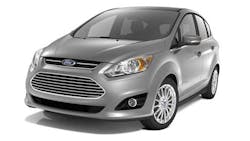Ford has announced plans to expand its Electrification Engineering team by 50% this year, growing to 500 salaried employees. The company also is investing $50 million more in electrified product development and testing centers in Dearborn, Mich. It will double its electrification and battery-testing capabilities by the end of the year as well to a total of 160 individual battery-test cells, helping to speed hybrid and electric vehicle development by as much as 25%, Ford says.
Related Articles
- Why Does EV-Phobia Plague Most British Drivers?
- Image Gallery: Go Further With Ford Electrics
- Five Hot Hybrids Hit The New York Auto Show
“This investment in new engineers and expanded facilities helps us prepare for growth,” said Raj Nair, group vice president of Ford Global Product Development. “All of us at Ford remain absolutely committed to offering customers a choice of leading fuel-efficient vehicles, from EcoBoost gasoline engines and hybrids to plug-in hybrids and electrified vehicles.”
Ford’s share of the U.S. electrified vehicle market grew to 16% in the first half of 2013. It reported electrified vehicle sales of 46,197 units through June, which is more than 400% higher than the same period a year ago, driven by sales of the C-MAX Hybrid and C-MAX Energi plug-in models (see the figure). Ford also says that 64% of C-MAX Hybrid buyers in June came from non-Ford brands.
The company also has plans for its larger vehicles with continued development of a real-wheel-drive hybrid system for its pickups and SUVs. The research began as a joint project with Toyota. The new system, which will be available by the end of the decade, will be based on an all-new architecture that will deliver the capability that SUV and truck customers demand while providing greater fuel economy, Ford says.
“We know what it takes to build world-class hybrids, and we now will build and leverage that expertise in-house,” Nair said. “By continuing to develop a rear-wheel-drive hybrid system on our own, we can extend our advanced hybrid technologies to new vehicle segments and deliver even better fuel economy across our lineup.”
The new staff will include more than 200 electrification engineers. Work will include the design and engineering of transmissions, batteries, and control systems, in addition to the new real-wheel-drive system. Over the past year, Ford has invested more than $355 million to design, engineer, and manufacture key components of its electrified vehicle lineup.
“Engineers and technical professionals are in as much demand as our cars, trucks, and SUVs,” said Felicia Fields, Ford group vice president for human resources. “Global demand and increasing capacity in North America and Asia requires that we aggressively seek out technical professionals in order to continue our growth.”
Overall, Ford plans on hiring more than 3000 salaried employees in 2013 in the United States, including 2400 technical professionals in product development, manufacturing, quality, purchasing, and information technology. According to Fields, more than 1500 of these positions remain open. Last year, Ford hired 1850 salaried workers in the United States.
In the immediate future, Ford says it wants to continue improving the on-road fuel economy performance of its 2013 hybrid vehicles in the United States and Canada. Starting in August, the company will make calibration updates designed to improve on-road fuel economy for owners of the 2013 Ford C-MAX Hybrid, the 2013 Ford Fusion Hybrid, and the 2013 Lincoln MZK Hybrid.
These calibration updates will include control system enhancements for a variety of highway driving conditions, short trips, and climate control system use. For example, the maximum pure electric speed will be increased from 62 mph to 85 mph for more electric-only highway driving. Active grill shutters will be optimized to reduce aerodynamic drag under more driving and temperature conditions.
Electric fan speed will be reduced as a function of coolant temperature to minimize its energy consumption. Engine warm-up time will be shortened by as much as 50% to enable electric-only driving and engine shutdown at stops sooner after cold starts. And, the climate control system will be optimized to minimize use of the air conditioning compressor and reduce the energy used in cold weather operation.
